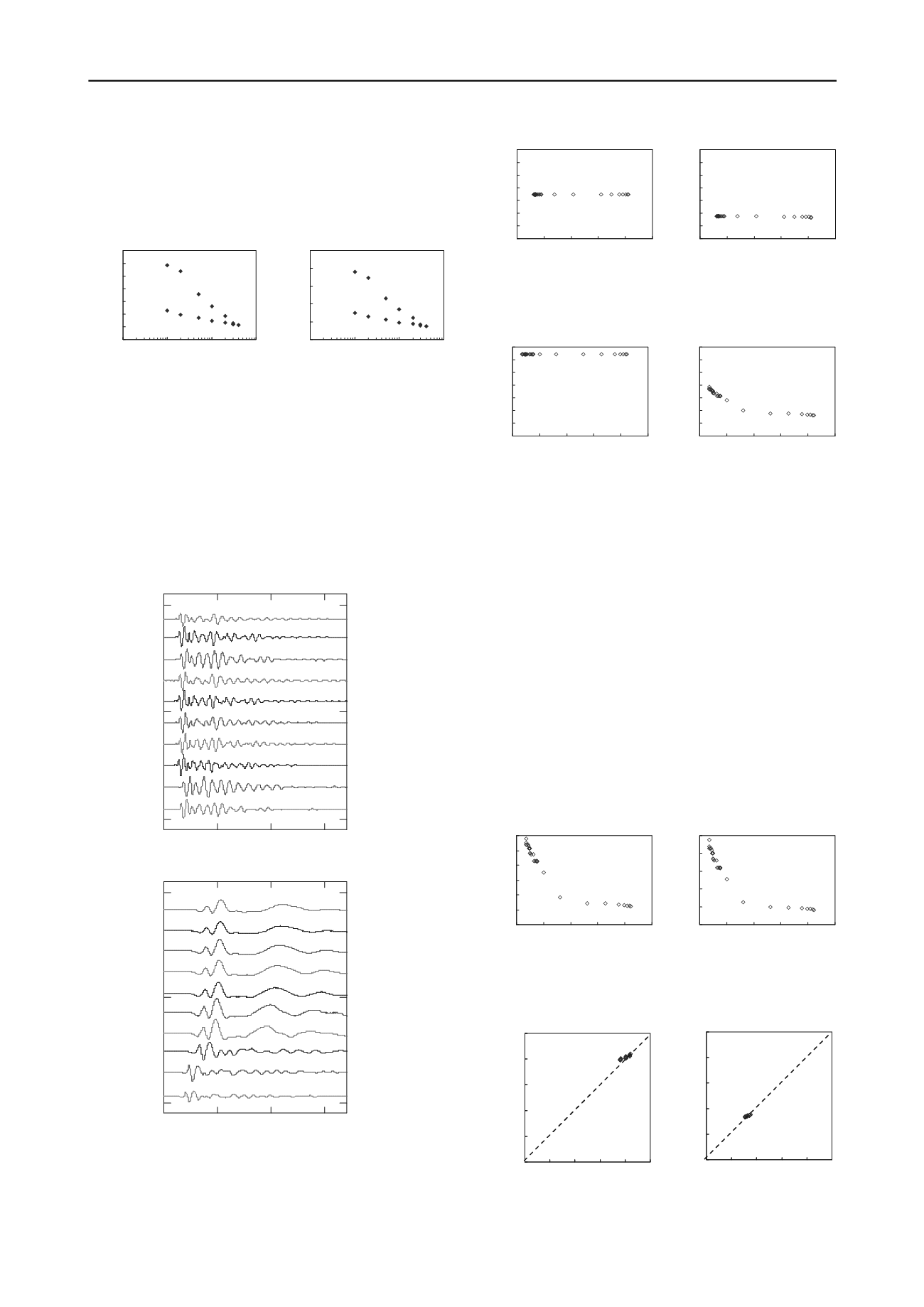
1091
Technical Committee 106 /
Comité technique 106
4 RESULTS
The matric suction versus volumetric water content, which is
called the soil water characteristic curve (SWCC), is plotted in
Figure 2 for the sand specimen.
(a)
(b)
Figure 2. Sand specimen (a) volumetric water content versus matric
suction; (b) degree of saturation versus matric suction.
Figure 2 shows that both the volumetric water content and the
degree of saturation gradually decrease as the matric suction
increases.
Elastic waves for the sand
–
silt mixture are plotted in Figure
3. Similar results were obtained for the sand specimen. The
elastic wave velocities determined from the measured waves are
plotted against the degree of saturation in Figure 4 for the sand
specimen and Figure 5 for the sand
–
silt specimen.
Figure 3. Measured elastic waves for the sand
–
silt mixture: (a)
compression waves; (b) shear waves.
(a)
(b)
Figure 4. Elastic wave velocities versus degree of saturation for the sand
specimen: (a) compression wave velocity; (b) shear wave velocity.
(a)
(b)
Figure 5. Elastic wave velocity versus degree of saturation for the sand
–
silt mixture specimen: (a) compression wave velocity; (b) shear wave
velocity.
The compression and shear waves for the sand specimen
remained almost constant for degrees of saturation from 15 to
85%, as shown in Figure 4. For the sand
–
silt mixture specimen,
the compression wave velocity also remained constant as the
degree of saturation decreased from 85% to 7%. The shear wave
velocity of the sand
–
silt mixture, however, increased as the
degree of saturation decreased, as shown in Figure 5(b).
5 ANALYSES
The elastic modulus and the shear modulus of each specimen
can be estimated using the measured elastic wave velocities.
The calculated elastic moduli based on Equations (2) and (3) are
plotted in Figure 6 for the sand
–
silt mixture specimen. From the
measured elastic wave velocities and Equation (5), the porosity
can be estimated. The calculated wave-based void ratio versus
volumetric void ratio is plotted in Figure 7. Figure 7 shows that
the wave-based void ratio is similar to the volumetric void ratio.
(a)
(b)
Figure 6. Elastic moduli versus degree of saturation for sand
–
silt
mixture specimen: (a) Young
’
s modulus; (b) shear modulus.
(a)
(b)
Figure 7. Wave-based void ratio versus volumetric void ratio: (a) sand
specimen; (b) sand
–
silt mixture specimen.
0
100
200
300
400
500
600
700
0 20 40 60 80 100
Degree of saturation,%
P-wave velocity,m/sec
.
0
100
200
300
400
500
600
700
0 20 40 60 80 100
Degree of saturation,%
S-wave velocity,m/sec
.
0
100
200
300
400
500
600
0 20 40 60 80 100
Degree of saturation,%
Young's modulus, MPa
.
0
50
100
150
200
250
0 20 40 60 80 100
Degree of saturation,%
Shear modulus, MPa
.
0
5
10
15
20
25
30
35
1
10
100
1000
Matric suction, kPa
Volumetric water content,%
0
20
40
60
80
100
1
10
100
1000
Matric suction, kPa
Degree of saturation, %
(a)
0
0.5
1
1.5
20
10
0
1min
4min
9min
16min
25min
1hr
2hr
4hr
6hr
24hr
time [ms]
(b)
0
0.5
1
1.5
20
10
0
1min
4min
9min
16min
25min
1hr
2hr
4hr
6hr
24hr
time [ms]
0
100
200
300
400
500
600
700
0 20 40 60 80 100
Degree of saturation,%
P-wave velocity,m/sec
.
0
100
200
300
400
500
600
700
0 20 40 60 80 100
Degree of saturation,%
S-wave velocity,m/sec
.
0.55
0.60
0.65
0.70
0.75
0.80
0.55 0.60 0.65 0.70 0.75 0.80
Volumetric void ratio
Wave based void ratio
.
0.55
0.60
0.65
0.70
0.75
0.80
0.55 0.60 0.65 0.70 0.75 0.80
Volumetric void ratio
Wave based void ratio
.


